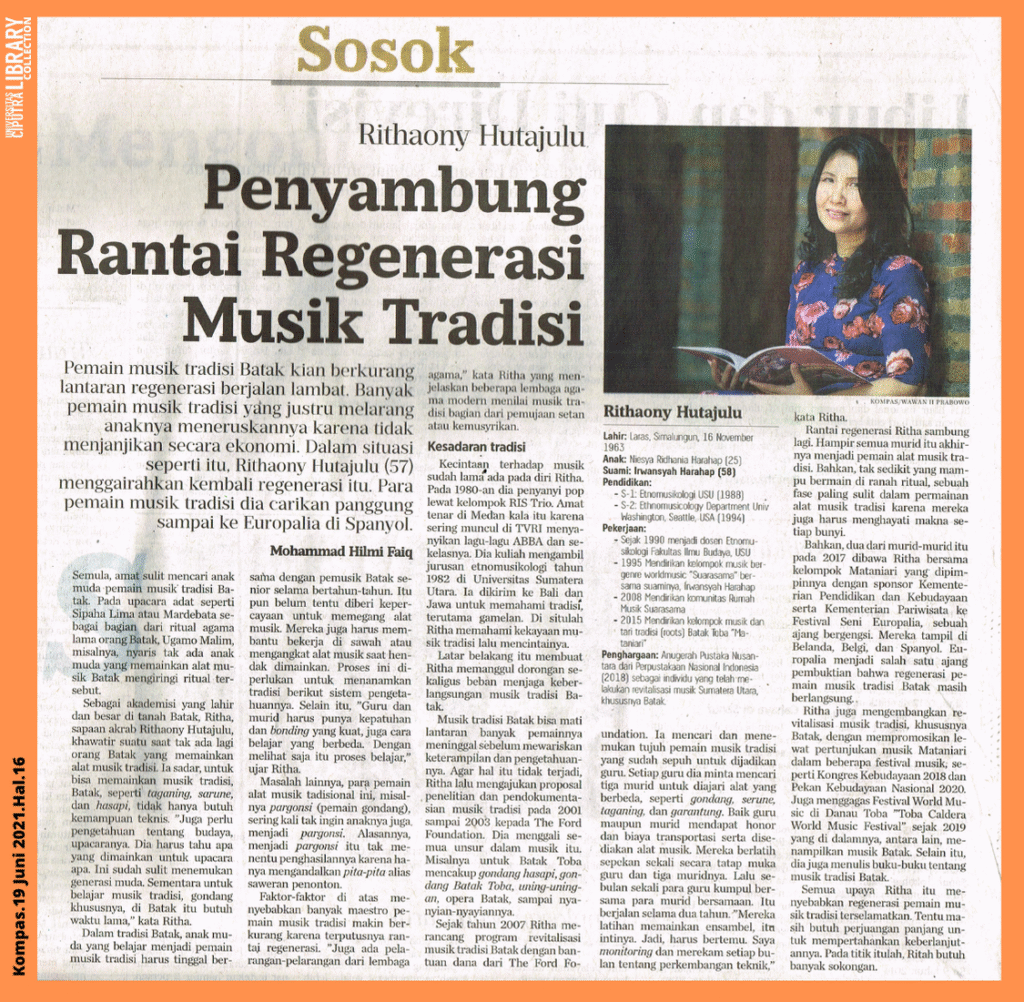Address
Jl. Stella 1 No. 27 Simpang Selayang Medan Tuntungan 20135
Work Hours
Monday to Friday: 7AM - 7PM
Weekend: 10AM - 5PM

Rithaony Hutajulu Revives the Lineage The number of traditional Batak musicians is steadily declining due to the slow pace of regeneration. Many traditional musicians even discourage their children from following in their footsteps, as it offers little economic promise. In such a situation, Rithaony Hutajulu (57) is reigniting the flame of regeneration. She seeks out performance opportunities for these musicians — even taking them to international stages such as Europalia in Spain.
Initially, it was extremely difficult to find young people who could play traditional Batak instruments. At cultural rituals such as Sipaha Lima or Mardebata — which are part of the Batak’s ancient religion, Ugamo Malim — there were hardly any young musicians playing traditional instruments to accompany the ceremonies.
As a scholar born and raised in the Batak homeland, Ritha (as she is affectionately known) feared that one day no Batak person would be able to play these traditional instruments. She understood that mastering traditional Batak music — instruments like the taganing, sarune, and hasapi — required not only technical skills.
“It also requires knowledge of culture and ritual. One must know which music is used for which ceremony. It’s already difficult to find young people willing to learn this. And learning traditional music — especially gondang — takes a long time,” Ritha said.
In Batak tradition, young people who want to become traditional musicians must live with a senior musician for years. Even then, they might not be allowed to touch the instruments at first. They must help with farm work or carry instruments before performances. This process is essential for instilling the tradition and its system of knowledge.
“Teachers and students must have deep respect, a strong bond, and a different way of learning. Even watching is part of the learning process,” Ritha added.
Another challenge: many traditional musicians — such as pargonsi (gondang players) — often don’t want their children to become musicians. The reason? The income is uncertain, often relying only on audience tips (pita-pita or saweran).
These factors contribute to the shrinking number of traditional music masters, as the chain of succession is broken.
“There are also bans from religious institutions,” Ritha explained, noting that some modern religious groups view traditional music as part of idolatry or superstition.
Cultural Awareness
Ritha’s love of music goes way back. In the 1980s, she was a pop singer with the group RIS Trio, which was popular in Medan and frequently appeared on TVRI, performing songs by ABBA and similar artists. In 1982, she studied ethnomusicology at the University of North Sumatra. She was later sent to Bali and Java to deepen her understanding of traditional music, especially gamelan. It was there that Ritha discovered her love for the richness of traditional music.
This background ignited both a passion and a sense of responsibility in Ritha to preserve Batak traditional music.
Without regeneration, Batak music traditions could die out, as many musicians pass away without passing on their skills and knowledge. To prevent this, from 2001 to 2003, Ritha proposed and carried out a documentation and research project on Batak traditional music, funded by The Ford Foundation. She explored various elements — from gondang hasapi, Batak Toba gondang, uning-uningan, Batak opera, to traditional songs.
In 2007, Ritha designed a revitalization program for Batak traditional music, again with support from The Ford Foundation. She identified and recruited seven elderly traditional musicians to serve as teachers. Each teacher was asked to train three students on different instruments: gondang, sarune, taganing, and garantung. Both teachers and students received stipends, transportation costs, and instruments. They trained once a week in person, and once a month, all teachers and students gathered for ensemble practice. This continued for two years.
“The core was to learn to play in an ensemble. So they had to meet regularly. I monitored and recorded their technical progress each month,” said Ritha.
This process successfully reconnected the chain of regeneration. Nearly all the students became traditional instrument players. Many were even able to perform in ritual settings — the most demanding aspect of traditional Batak music — where understanding the meaning behind each sound is essential.
In 2017, Ritha took two of her students to the Europalia Art Festival, with her group Mataniari, supported by the Ministry of Education and Culture and the Ministry of Tourism. They performed in the Netherlands, Belgium, and Spain. Europalia was a testament that the regeneration of Batak traditional musicians was alive and ongoing.
Ritha also promoted the revitalization of Batak traditional music through Mataniari’s performances at various festivals, including the 2018 Indonesian Cultural Congress and 2020 National Culture Week. She also co-founded the Toba Caldera World Music Festival in Lake Toba in 2019, which features Batak music among others. In addition, she has written several books on Batak traditional music.
Thanks to all of Ritha’s efforts, the regeneration of Batak traditional musicians has been preserved. Yet, a long struggle remains to ensure its continued survival. It is in this pursuit that Ritha needs more support.
Source: Kompas, June 19, 2021, p.16.


